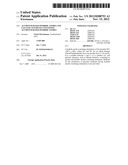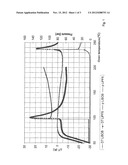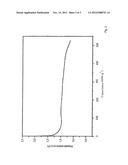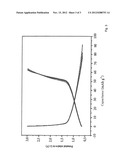Patent application title: ALUMINUM-BASED HYDRIDE ANODES AND GALVANIC ELEMENTS CONTAINING ALUMINUM-BASED HYDRIDE ANODES
Inventors:
Ulrich Wietelmann (Friedrichsdorf, DE)
IPC8 Class:
USPC Class:
429188
Class name: Chemistry: electrical current producing apparatus, product, and process current producing cell, elements, subcombinations and compositions for use therewith and adjuncts include electrolyte chemically specified and method
Publication date: 2012-11-15
Patent application number: 20120288753
Abstract:
A hydride anode containing aluminium of the formula
(M1)m(M2)3-mAlH6, where M1 and M2 are
an alkali element selected independently from one another from Li, Na and
K; m is a number between 1 and 3; n is a number ≧3, and galvanic
elements, such as lithium batteries, containing as anodes said hydride
anodes containing aluminum. Methods for the production of galvanic
elements having hydride anodes containing aluminium is also provided.Claims:
1-15. (canceled)
16. A galvanic element comprising an aluminum-based hydride anode, a cathode containing a transition metal, and an aprotic lithium electrolyte.
17. A galvanic element according to claim 16, wherein the aluminum-based hydride anode in the discharged state contains or is composed of a binary or ternary aluminum hydride of the formula (M1)m(M2)3-mAlH6, wherein M1 and M2 are an alkali element independently selected from Li, Na, and K; m is a number between 1 and 3; and n is a number ≧3.
18. A galvanic element according to claim 16, wherein the binary or ternary aluminum hydride is Li3AlH.sub.6.
19. A galvanic element according to claim 16, wherein a partially or completely lithiated lithium insertion material is a cathode.
20. A galvanic element according to claim 16, wherein the lithium insertion material is selected from the group consisting of a lithium metal oxide, a lithiated phosphate, a lithiated silicate and a mixed lithiated fluorometal oxide.
21. A method for producing a lithium battery, wherein an anode containing a binary or ternary metal aluminum hydride of the general formula (M1)m(M2)3-mAlH6, wherein M1 and M2 are an alkali element independently selected from Li, Na, and K; m is a number between 1 and 3; and n is a number ≧3, is brought into contact with a partially or completely lithiated lithium insertion material by means of a separator/electrolyte composite.
22. A method according to claim 21, wherein the lithium insertion material represents a lithium metal oxide, a lithium phosphate, a lithium silicate, or a lithiated fluorometal oxide, or a mixture of the named substance groups.
23. A method according to claim 21, wherein an anode containing a mixture of lithium hydride and aluminum metal, an aluminum-lithium alloy, and/or a mixture of the metals aluminum and lithium is brought into contact with a partially or completely delithiated or lithium-free lithium insertion material by means of a separator/electrolyte composite.
24. A method according to claim 23, wherein the lithium insertion material is a lithium metal oxide, a lithium phosphate, a lithium silicate, or a lithiated fluorometal oxide, or a mixture of the named substance groups.
25. A negative electrode composition for a galvanic element, wherein the negative electrode composition in the discharged state contains or is composed of a binary or ternary aluminum hydride of the formula (M1)m(M2)3-mAlH6, wherein M1 and M2 are an alkali element independently selected from Li, Na, and K; m is a number between 1 and 3; and n is a number ≧3.
26. A negative electrode composition according to claim 25, wherein the binary or ternary aluminum hydride is Li3AlH.sub.6.
27. A negative electrode composition according to claim 25, wherein the negative electrode composition in the charged state contains or is composed of lithium hydride and aluminum metal.
28. A negative electrode composition according to claim 25, wherein the negative electrode composition contains conductivity-enhancing additives, for example graphite or conductive carbon black.
29. A method of preparing a mixture of lithium hydride and aluminum metal comprising reacting lithium aluminum hydride with lithium metal in a polar, aprotic solvent.
30. A method of preparing a mixture of lithium hydride and aluminum metal by reacting lithium hexaaluminum hydride with lithium metal in a grinding process or thermally at temperatures above 180.5.degree. C.
31. The method of claim 30, wherein the process is said grinding process.
32. The method of claim 30, wherein the process is said thermal process.
Description:
PRIOR ART
[0001] Currently used rechargeable lithium batteries contain graphite as anode material. Graphite functions as lithium insertion material, and according to the equation
Li+6C→LiC6
has a theoretical capacitance of 372 mAh/g at a potential of approximately 0.2 V relative to Li/Li.sup.+. Use cannot be made of the significantly higher storage capacitance of lithium metal (3860 mAh/g) in batteries in practical application, since such batteries are not safe or cyclically stable. During cycling, the lithium metal sometimes separates not in planar form, but in the form of outgrowths (dendrites). These outgrowths may lose physical contact with the metal anode, causing the capacitance of the electrochemical cell to decrease. Even more serious are the consequences when needle-shaped dendrites penetrate the separator. The battery cell may thus be short-circuited, with often catastrophic effects: thermal run-away, usually accompanied by fire.
[0002] Therefore, efforts have been made to use metal lithium alloys instead of pure lithium as anode material. However, lithium alloys exhibit extreme fluctuations in volume during incorporation and withdrawal of the lithium (sometimes by several multiples of 100%, for example 238% for Li9Al4). For this reason, alloy anodes have not been commercially successful, with the exception of tin-graphite composites. However, tin is a rare and expensive element, which has prevented the widespread use of materials containing tin.
[0003] Tarascon and Aymard have proposed a battery in which lithium hydride is used as the negative electrode (anode) (EP 2026390 A2):
MHx+LixLiH+M (1)
wherein M=La, Mg, Ni, Na, Ti.
[0004] However, the Mg-based system described in the above-cited patent document has pronounced hysteresis, and heretofore its functionality has not been demonstrated in an actual lithium battery.
DESCRIPTION OF THE INVENTION
[0005] It has surprisingly been found that galvanic elements, for example lithium batteries, which in the discharged state contain a binary or ternary aluminum hydride in the negative electrode composition are stable, and the negative electrode compositions have high lithium intake and release activity. Compounds containing the tetrahydridoaluminate anion (AlH4.sup.-) are not suitable as aluminum hydride. Thus, commercially available LiAlH4 is readily soluble in polar, aprotic solvents such as glycol ethers. In addition, LiAlH4 is a very powerful reducing agent, so that even at room temperature it reacts extremely vigorously with common battery electrolytes containing carbonates, carboxylates, lactones, and/or nitriles. It has surprisingly been found that metal aluminum hydrides containing the hexahydridoaluminate anion (AlH63-) are insoluble in the named electrolytes and are compatible with same; i.e., a spontaneous reaction does not occur. For this reason, hexahydridoaluminate salts may be used in galvanic cells containing aprotic electrolytes, for example lithium batteries. Due to their low potential relative to Li/Li.sup.+, they may preferably be used as anodes (negative electrode).
[0006] The lithium charging and discharging process of the negative electrode (anode) may be described by the following equation:
(M1)m(M2)3-mAlH6+nLimM1H+3-mM2H+AlLi.- sub.n-3 (2)
wherein M1 and M2 are an alkali element independently selected from Li, Na, and K; m is a number between 1 and 3; and n is a number ≧3.
[0007] It is particularly preferred that M1=M2=lithium, and n is 3 or 4, particularly preferably 3.
[0008] The following discussion concerns this particularly preferred embodiment of the invention; i.e., in the discharged state the anode contains Li3AlH6.
[0009] There are various options for using Li3AlH6 as the anode for galvanic elements. Thus, these hydride anodes may be connected to a lithiated insertion material, for example a lithium metal oxide LixM3Oy. Accordingly, the electrode reactions are as follows:
Li3AlH63/xLixM3yOz6LiH+Al+3/xM3y- Oz (3)
wherein M3 is a redox-active metal selected from the group Co, Ni, Mn, Fe, V, Cr, Ti; x is an integer between 1 and 3; and y and z are integers between 1 and 4.
[0010] The following lithium metal oxides are particularly preferred: LiCoO2, LiNiO2, LiMn2O4, Li2MnO3, LiVO2, and mixed metal oxides such as Li(Ni1/3Mn1/3Co1/3)O2, Li(Ni0.85Co0.15)O2, or LiFe0.5Mn1.5O4.
[0011] Other lithium insertion materials such as lithium phosphates (LiFePO4, LiVPO4, LiMnPO4, for example), lithium silicates (Li2FeSiO4, Li2MnSiO4, Li2CoSiO4, for example), and mixed lithiated fluorometal oxides may be used instead of a metal oxide.
[0012] It is also possible to connect the Al-containing hydride anode according to the invention in discharged form to lithium-free cathode materials. In this case, an additional lithium source must be incorporated. This lithium source is either pure lithium metal, for example in powdered form, or an alloy containing lithium metal. Pure lithium metal is preferably used, in which case a mixture of lithium hydride and aluminum forms in situ (during the first charging process):
Li3AlH6+3Li→6LiH+Al (4)
[0013] Accordingly, the electrode redox reaction is as follows:
6LiH+Al+3/xM3yOzLi3AlH6+3/xLixM3yOz (5)
[0014] The theoretical gravimetric capacitance of Li3AlH6 is 1496 Ah/kg, and is thus approximately four times that of graphite.
[0015] If the lithium is used in excess in equation (4), a mixture of the metals Li and Al and/or an alloy of elemental aluminum and lithium is/are formed in addition to lithium hydride:
Li3AlH6+(3+a)Li→6LiH+AlLia (6)
wherein a is a number between 0 and 5, preferably between 0 and 2.
[0016] Accordingly, the electrode redox reaction is as follows:
6LiH+AlLia3/xM3yOzLi3AlH6+aLi+3/xLixM- 3yOz (7)
[0017] When the connection is made to a lithium-loaded insertion cathode, the hydride anodes are preferably used in the discharged state, i.e., in the form of Li3AlH6. When lithium manganese spinel, for example, is used, according to general equation (3) the galvanic cell has the following electrode configuration (cathode//anode):
3LiMn2O4//Li3AlH6
Li3AlH6+3LiMn2O46LiH+Al+3Mn2O4 (3a)
[0018] According to the invention, it is also possible to connect the discharged hydride anode to a mixture of lithium metal and the partially or completely lithium-free lithium insertion cathode. Accordingly, the configuration is as follows:
3Li+Mn2O4//Li3AlH6
[0019] The lithiation of the cathode material may be carried out either ex situ (i.e., outside the galvanic cell) or in the installed cell during cyclization.
[0020] When a lithium-free (or low-lithium) insertion cathode is combined with the aluminum-based hydride anode according to the invention, the latter is preferably used in the charged state. For example, the aluminum-based hydride anode may be connected to a cathode composed of a Braunstein's modification:
3MnO2//6LiH+Al
6LiH+Al+3MnO2Li3AlH6+3LiMnO2 (5a)
[0021] Lastly, it is possible to connect a mixture of Li3AlH6 and lithium metal to a lithium-free (or low-lithium) insertion cathode, for example NiO2:
3NiO2//Li3AlH6+6Li
Li3AlH6+6Li+3NiO26LiH+Al+3LiNiO2 (8)
[0022] The optimal stoichiometric ratios are indicated in the above reaction equations and electrode configurations. However, it may be appropriate to deviate from these ratios, for example to increase the electrode stability.
[0023] For example, the theoretical molar ratio for the charged Al-containing hydride anode according to the invention is 6 LiH:1 Al. If less LiH is used relative to Al, for example only a molar ratio of 4:1, it is not possible to convert all the aluminum to the discharged form (the hexahydride), Instead, a portion of the aluminum remains in elemental form, even after the charging. Accordingly, the electrode configuration and the charging-discharging equation are as follows when a Braunstein's modification is used as cathode:
2MnO2//4LiH+Al
4LiH+Al+2MnO22/3Li3AlH6+1/3Al+2LiMnO2 (5b)
[0024] The aluminum which does not participate in the redox process results in a lower change in volume of the anode during cyclization; i.e., the aluminum stabilizes the anode, thus further improving the cycle stability.
[0025] If the hydride anode material according to the invention is used in the charged state, the molar ratio of LiH to Al or to AlLia may assume values between 0.5:1 and 10:1. Similarly, the molar ratio of Li3AlH6 to Li may assume values between 1:1 and 1:20.
[0026] If the Al-containing hydride anode material according to the invention is used in discharged form (i.e., as Li3AlH6), it is likewise possible to use the Al-containing hydride anode material in a mixture with aluminum and/or Lift Molar ratios of Li3AlH6, Al and LiH according to the invention are generally in the range between 1:0:0 and 1:0.1-2:0.1-12.
[0027] The Al-containing hydride anode material according to the invention is preferably present in powdered form. The particle size is generally <100 μm, particularly preferably <30 μm. Conductivity-enhancing additives, for example graphite, conductive carbon black, or finely divided metals (Ti powder, for example), are preferably admixed with the hydride anode materials according to the invention.
[0028] Types of electrolytes known to one skilled in the art (liquid, gel, polymer, and solid electrolytes) are suitable as electrolytes. The lithium salts containing weakly coordinating, oxidation-stable anions which are soluble in or otherwise introducible into such products are used as conducting salt. For example, these include in particular LiPF6, lithium fluoroalkyl phosphates, LiBF4, imide salts (LiN(SO2CF3)2, for example), LiOSO2CF3, methide salts (LiC(SO2CF3)3, for example), LiClO4, lithium chelatoborates (LiBOB, for example), lithium fluorochelatoborates (LiC2O4BF2, for example), lithium chelatophosphates (LiTOP, for example), and lithium fluorochelatophosphates (Li(C2O4)2PF2, for example). Particularly preferred are salts containing anions which are stable against anionic dissociation and free of fluorine. It has surprisingly been found that when fluorine-free conducting salts such as chelatoborates and chelatophosphates are used, electrolytes are much more stable in contact with the aluminum-based hydride anodes according to the invention, so that their use results in galvanic cells having much better safety characteristics than is the case when salts containing labile anions (LiPF6, for example) are used. It is presumed that, due to anionic dissociation according to:
LiPF6→LiF+PF5 (9),
[0029] LiPF6-based electrolytes form reactive species (the Lewis acid PF5 and/or secondary products therefrom) which are able to react exothermically with the aluminum-based hydride anodes according to the invention, even at relatively low temperatures.
[0030] The discharged hydride anode material is produced according to the prior art, for example by reacting lithium aluminum hydride with organolithium compounds according to
2CnH2n+1Li+LiAlH4→Li3AlH6+2CnH2n
(R. Ehrlich, J. Amer. Chem. Soc. 88 (1966) 858-860).
[0031] The charged Al-containing hydride anode material according to the invention is produced, for example, by mixing lithium hydride and aluminum powder. If the individual components do not have the desired particle size distribution, i.e., they are too coarse, for example, they may be ground, separately or particularly preferably in a mixture. This procedure is carried out, with the exclusion of air and moisture, under a hydrogen or inert gas atmosphere, for example using a ball mill or rod mill. In one particularly preferred method variant, a conductivity-enhancing additive is added to and ground with the mixture.
[0032] A particularly preferred fine material is obtained by reacting lithium metal with lithium aluminum hydride in an aprotic polar solvent according to:
LiAlH4+3Li→4LiH+Al
[0033] Ethers, for example diethyl ether, dibutyl ether, methyl tert-butyl ether, tetrahydrofuran, or methyltetrahydrofuran, are preferably used as solvent.
[0034] Alternatively, this reaction may be carried out in the absence of solvent in an autoclave at temperatures above 150'C.
[0035] Another particularly preferred method for preparing a lithium hydride/aluminum mixture is the reaction of Li3AlH6 with lithium metal:
Li3AlH6+3Li→6LiH+Al
[0036] This reaction is preferably carried out either in a grinding process or thermally within the substance (i.e., in the absence of solvent) at temperatures above the melting point of lithium (180.5° C.). A mixture of elemental Li and Al or a Li/Al alloy is obtained when the lithium is used in excess.
[0037] The invention relates in particular to: [0038] a galvanic element composed of an aluminum-based hydride anode, a cathode containing a transition metal, and an aprotic lithium electrolyte; [0039] preferably a galvanic element in which the aluminum-based hydride anode in the discharged state contains or is composed of a binary or ternary aluminum hydride of the formula (M1)m(M2)3-mAlH6, wherein M1 and M2 are an alkali element independently selected from Li, Na, and K; m is a number between 1 and 3; and n is a number ≧3; [0040] particularly preferably a galvanic element in which the binary or ternary aluminum hydride is Li3AlH6; [0041] very particularly preferably a galvanic element in which a partially or completely lithiated lithium insertion material is used as cathode (positive electrode composition); [0042] more preferably a galvanic element in which a lithium metal oxide, a lithiated phosphate, a lithiated silicate, or a mixed lithiated fluorometal oxide is used as lithium insertion material.
[0043] The invention further relates to: [0044] a method for producing a lithium battery, in which an anode containing a binary or ternary metal aluminum hydride of the general formula (M1)m(M2)3-mAlH6, wherein M1 and M2 are an alkali element independently selected from Li, Na, and K; m is a number between 1 and 3; and n is a number 3, is brought into contact with a partially or completely lithiated lithium insertion material by means of a separator/electrolyte composite; [0045] preferably a method in which the lithium insertion material represents a lithium metal oxide, a lithium phosphate, a lithium silicate, or a lithiated fluorometal oxide, or a mixture of the named substance groups; [0046] particularly preferably a method in which an anode containing a mixture of lithium hydride and aluminum metal, an aluminum-lithium alloy, and/or a mixture of the metals aluminum and lithium is brought into contact with a partially or completely delithiated or lithium-free lithium insertion material by means of a separator/electrolyte composite; [0047] very particularly preferably a method in which the lithium insertion material represents a lithium metal oxide, a lithium phosphate, a lithium silicate, or a lithiated fluorometal oxide, or a mixture of the named substance groups.
[0048] The invention further relates to: [0049] a negative electrode composition for a galvanic element which in the discharged state contains or is composed of a binary or ternary aluminum hydride of the formula (M1)m(M2)3-mAlH6, wherein M1 and M2 are an alkali element independently selected from Li, Na, and K; m is a number between 1 and 3; and n is a number ≧3; [0050] preferably a negative electrode composition in which the binary or ternary aluminum hydride is Li3AlH6; [0051] particularly preferably a negative electrode composition which in the charged state contains or is composed of lithium hydride and aluminum metal; [0052] very particularly preferably a negative electrode composition which contains conductivity-enhancing additives, for example graphite or conductive carbon black.
[0053] Lastly, the invention relates to: [0054] the preparation of a mixture of lithium hydride and aluminum metal by reacting lithium aluminum hydride with lithium metal in a polar, aprotic solvent; and [0055] preferably the preparation of a mixture of lithium hydride and aluminum metal by reacting lithium hexaaluminum hydride with lithium metal either in a grinding process or thermally, at temperatures above 180.5° C.
[0056] The invention is explained below with reference to two examples and three figures, which show the following:
[0057] FIG. 1: shows the thermal stability of Li3AlH6 in contact with electrolyte solutions (Radex experiments);
[0058] FIG. 2: shows the first charging of Li3AlH6 in the potential range of 0.6-3 V; and
[0059] FIG. 3: shows the second through fifth charging-discharging cycles of Li3AlH6 in the potential range of 0.6-3 V.
EXAMPLE 1
Thermal Stability of a Mixture of Li3AlH6 and Various Electrolyte Solutions (DSC Tests)
[0060] An apparatus from Systag, Switzerland (Radex system) was used for differential scanning calorimetry (DSC) tests. Approximately 2 g electrolyte solvent and 0.1 g Li3AlH6 were weighed into the stainless steel sample containers, under a protective gas atmosphere. The containers were sealed tight with a lid connected to a pressure gauge. The samples were then heated at a rate of 45 K/h to 200° C. (13% solution of LiPF6 in EC/EMC (1:1)) and to 250° C. (13% LiBOB solution in EC/EMC (1:1)).
[0061] The experiment showed that the anode material Li3AlH6 according to the invention in LiPF6 electrolyte was stable to approximately 80° C. Above this temperature, the mixture decomposed with intense heat release and pressure buildup (100 bar). In contrast, the mixture containing the lithium bis(oxalato)borate (LiBOB) was stable to above 200° C.
EXAMPLE 2
Charging-Discharging Behavior of Li3AlH6
[0062] All electrochemical experiments were conducted in an Ar-filled glove box. Three-electrode glass cells containing the Al hydride material as anode, lithium metal as cathode, and likewise lithium metal as reference electrode were produced. The anode was prepared by mixing the active material (Li3AlH6 or LiH/Al mixture) with a graphite-based conductivity additive and PTFE. The anode mixture was pressed onto a nickel mesh. A 12% solution of LiPF6 in EC/DMC was selected as electrolyte.
[0063] Lithium incorporation at a potential of approximately 1 V is apparent in FIG. 2.
[0064] FIG. 3 demonstrates that the lithium incorporation is reversible. The relatively low charge/discharge capacitance is due to the non-optimized electrode preparation (the electronic contact between the particles is not adequately ensured).
User Contributions:
Comment about this patent or add new information about this topic:




